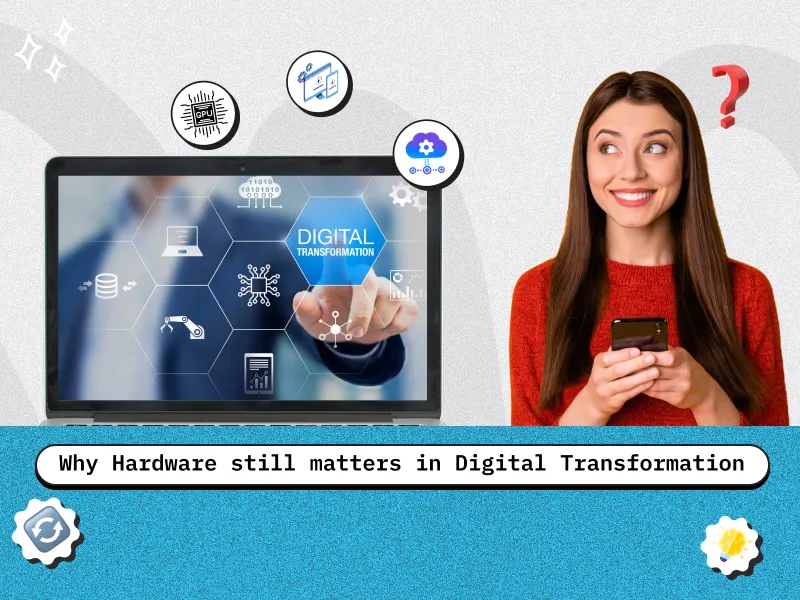TL;DR
- Hardware is the foundation for all digital transformation efforts.
- Software and cloud solutions rely on reliable physical systems to function.
- AI, IoT, and automation require high-performance processors, GPUs, and PCBs.
- Strong hardware ensures smooth software development, reduces downtime, and boosts security.
- Businesses that align hardware and software strategies achieve scalable, long-term digital growth.
Introduction
Digital transformation is often painted as a software-first movement — cloud platforms, mobile apps, AI tools, and automation solutions get all the spotlight. But the reality is simple: none of these innovations can exist without the right physical infrastructure behind them. From servers and GPUs to PCBs, edge devices, and industrial systems, hardware forms the backbone that enables software to function, scale, and deliver results.
Without strong hardware, even the most advanced digital solutions can slow down, fail, or expose businesses to risk. Performance, uptime, security, and growth all depend on reliable physical systems working silently in the background. In this blog, we reveal why hardware still drives digital transformation and why companies must align hardware and software strategies to stay competitive — partnering with a trusted digital transformation company makes that alignment real.
Hardware: The Foundation People Forget
When people talk about digital transformation, they usually jump straight to software platforms, apps, and cloud solutions. And fair enough software drives most of the headlines. But here’s the truth: without reliable hardware, none of that software can even get off the ground.
Companies like OurPCB make it clear that reliable hardware isn’t just an afterthought—it’s the backbone of any serious digital transformation effort. Whether you’re running a cloud platform, rolling out IoT devices, or automating a factory floor, you need strong, stable hardware at the heart of it.
Think of it like building a house. You can design the most beautiful interior (software), but if the foundation (hardware) is weak, cracks show up fast.
Software Gets the Spotlight, But Hardware Carries the Load
Software gets the buzz. It’s sleek, it updates overnight, and it feels like magic when it works. Hardware, by contrast, feels old-school—wires, boards, circuits. But here’s the kicker: without the boards and devices holding everything together, that “magic” collapses.
Consider cloud computing. Everyone talks about the “cloud” as if it’s floating somewhere intangible. But the cloud is just servers housed in warehouses, filled with motherboards, chips, and power supplies. Strip away the metal and silicon, and the cloud vanishes.
It’s the same with AI. Those large language models (yes, the very ones reshaping how businesses interact with data) demand powerful GPUs and processors. Without the right hardware, AI remains just an idea.
Where Hardware Meets Digital Transformation
Digital transformation isn’t a software-only journey. In fact, some of the most exciting changes in business today come from where hardware and software collide:
- IoT (Internet of Things): Billions of devices—from smart thermostats to industrial sensors—depend on custom PCBs and components to transmit data. According to Gartner, IoT devices are exploding in number, making hardware critical to scaling.
- AI & Machine Learning: High-powered GPUs, processors, and chips fuel these algorithms. No silicon, no smarts.
- Cloud & Edge Computing: Hardware decisions affect speed, storage, and reliability for businesses expanding digitally.
When creating a new IoT device or AI-powered solution, hardware reliability is key even at the prototype stage. A weak PCB or processor can compromise test results, making accurate prototyping impossible — just as using clear, automated video summarization tools like Notta can help teams efficiently analyze test sessions and documentation without losing critical context.
The Business Case: Costs, Risks, and Reliability
Let’s get practical. Why should executives and managers pay more attention to hardware?
- Downtime Costs Money – A failed PCB in a production line can bring operations to a halt. That downtime isn’t just inconvenient—it’s expensive.
- Longevity Matters – High-quality hardware lasts longer, reducing replacement costs.
- Security Starts in Hardware – From encrypted chips to secure boards, hardware plays a major role in keeping systems safe.
According to McKinsey, businesses spend billions annually on digital transformation. Yet too often, hardware planning is overlooked, leaving companies exposed to risks that no software patch can fix.
And let’s not forget better hardware simplifies integration with custom software solutions, whether for full-scale deployment or MVP development. If you’re working with a software partner, having solid hardware ensures their work runs smoothly in real-world environments.
Looking Ahead: Why Hardware Will Always Have a Seat at the Table
Some people imagine a future where software reigns supreme and hardware fades into the background. Honestly? That’s wishful thinking. As technology grows more complex, hardware will quietly remain the silent partner doing the heavy lifting behind the scenes.
From self-driving cars that depend on sensor arrays, to smart cities wired with thousands of connected devices, to healthcare systems where even a minor glitch can affect lives—hardware is still the unsung hero.
And if your organization is planning a full-scale digital transformation It’s not just about cloud subscriptions or flashy dashboards. It’s about making sure the hardware foundation is strong enough to carry all that ambition. A full-stack approach including trusted hardware partners and capable software firms is what separates success from frustration.
Conclusion
Digital transformation is often seen as all about software, but the truth is more grounded. Hardware is still essential. Every cloud server, IoT device, AI processor, and software development project depends on reliable physical systems to work.
So, when someone says digital transformation is just software, think: what happens if the hardware fails? Without strong hardware, even the best software development efforts can stop working. Hardware is the silent backbone that makes digital progress possible.
FAQs
1. Why is hardware important in digital transformation?
Hardware provides the foundation for all digital systems. Servers, GPUs, PCBs, and edge devices ensure software, AI, IoT, and cloud platforms run efficiently and reliably.
2. Can digital transformation succeed without hardware?
No. Even the most advanced software and cloud solutions rely on physical infrastructure. Weak or unreliable hardware can cause downtime, slow performance, and security risks.
3. How does hardware impact software development?
Hardware sets the limits for software performance, scalability, and reliability. Strong hardware ensures smoother development, testing, and deployment of digital solutions.
4. What role does hardware play in AI and IoT?
AI requires high-powered GPUs and processors, while IoT depends on custom PCBs and devices. Hardware enables data processing, connectivity, and real-time analytics.
5. How can businesses choose the right hardware for digital transformation?
Consider reliability, scalability, and compatibility with existing software systems. Partnering with trusted hardware and software vendors ensures smooth operations and long-term growth.
6. Is hardware still relevant for cloud computing?
Absolutely. Cloud servers are built on physical infrastructure. The speed, storage, and uptime of cloud services all depend on quality hardware.
7. What risks come from ignoring hardware in digital transformation?
Ignoring hardware can lead to system failures, downtime, slower software performance, and increased security vulnerabilities, ultimately affecting business growth.











 30 mins free Consulting
30 mins free Consulting 
 6 min read
6 min read 







 Love we get from the world
Love we get from the world 